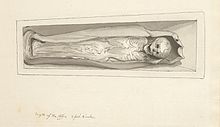Hugh of Lincoln (ritual murder legend)
Hugh of Lincoln (also St Hugh of Lincoln or Little St Hugh ) (* around 1246; † uncertain: August 27, 1255 in Lincoln ) was an English boy whose death led to a ritual murder charge against Jews.
The alleged ritual murder
Hugh was from Lincoln , his mother's name was Beatrice. He is also known as Little Hugh to distinguish him from the canonized Bishop Hugo of Lincoln . According to reports at the time, Beatrice is said to have learned that her son had played with Jewish children of the same age. It appears that Hugh had indeed been killed in an accident, but reports say the children went to a Jewish resident's home. A few days later the boy's body was found in a well or a pit in the house of the Jew Copin (also Jopin ). There are various accounts of the duration of Hugh's alleged imprisonment, ranging from ten days to 26 days. After the body was found, Copin was arrested immediately. Judge John of Lexinton saw the case as a ritual murder , presumably he knew the story of the young William of Norwich , who is said to have been the victim of a ritual murder as early as 1144. Lexinton got Copin to confess to the murder and describe details of the ritual. In return, he is said to have assured him that he would not be tortured or executed. According to Matthew Paris's report , the intimidated Copin confessed that not only all the Jewish residents of Lincoln, but that Jews from all over England had come to Lincoln and participated in the ritual murder. Then the boy was scourged , crowned with a crown of thorns and then crucified. Then the body was gutted and used for magical purposes.
Consequences for the Jewish population
This admission by Copin resulted not only in the persecution of the Jewish residents of Lincoln, but in attacks and rioting against Jews across England. Contrary to Lexinton's promise, Copin was ordered by King Henry III. executed, where he was dragged to the gallows by a horse. Eighteen other Jews were hung to death in London, while 91 others were incarcerated in the Tower . After initially either the Franciscans or the Dominicans had stood up for them in vain, they were finally released after paying a heavy fine to Richard of Cornwall , who was entitled to the taxes of the Jewish population.
Aftermath and artistic reception
Many miracles have been said of the body of young Hugh. Copin himself is said to have testified that the grave the Jews dug for him threw the body again. They then threw the body into the well. A blind woman is said to have regained her eyesight after washing her eyes with water from this well. The alleged martyrdom and miracle accounts led to Bishop Henry of Lexinton , a brother of the judge , having the body buried in Lincoln Cathedral in 1255 . There his shrine was popularly venerated in the Middle Ages, his traditional day of remembrance is July 27th. An official canonization never took place. The story of the ritual murder was first told in a French ballad , which later became the model for numerous other ballads and stories.
literature
- Karl-Heinz Göller: Sir Hugh of Lincoln. From History to Nursery Rhyme . In: Bernd Engler, Kurt Müller: Jewish Life and Jewish Suffering as Mirrored in English and American Literature . Schöningh, Paderborn 1987, ISBN 3-506-70816-3 , pp. 17-31.
- Joseph Jacobs: Little St Hugh of Lincoln . In: Jewish ideals and other essays , Nutt, London 1896, pp. 192-224
- Gavin I. Langmuir: The knight's tale of young Hugh of Lincoln , in: Speculum 47 (1972), pp. 459-482
- Richard Utz: Remembering Ritual Murder: The Anti-Semitic Blood Accusation Narrative in Medieval and Contemporary Cultural Memory . In Eyolf Østrem: Genre and Ritual: The Cultural Heritage of Medieval Rituals . Museum Tusculanum Press, Copenhagen 2005. ISBN 87-635-0241-0 , pp. 145-162
- Richard Utz: The Medieval Myth of Jewish Ritual Murder. Toward a History of Literary Reception . In: The Year's Work in Medievalism, 14 (1999), pp. 22-42
Web links
- Haidee J. Lorrey: Hugh of Lincoln (c.1246-1255). In: Henry Colin Gray Matthew, Brian Harrison (Eds.): Oxford Dictionary of National Biography , from the earliest times to the year 2000 (ODNB). Oxford University Press, Oxford 2004, ISBN 0-19-861411-X , ( oxforddnb.com license required ), as of 2004
| personal data | |
|---|---|
| SURNAME | Hugh of Lincoln |
| ALTERNATIVE NAMES | St Hugh of Lincoln; Little St Hugh |
| BRIEF DESCRIPTION | alleged ritual murder victim |
| DATE OF BIRTH | around 1246 |
| DATE OF DEATH | uncertain: August 27, 1255 |
| Place of death | Lincoln |

